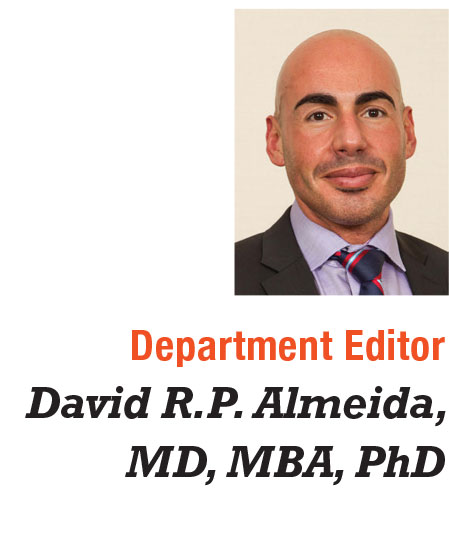 |
|
Bio Dr. Almeida is a vitreoretinal surgeon at Erie Retinal Surgery in Erie, Pa. DISCLOSURE: Dr. Almeida reports no relevant financial relationships. Twitter: @davidalmeidamd Email: [email protected] |
I recently attended the American Academy of Ophthalmology annual meeting in New Orleans. With COVID-19 precautions in place, live seminars have the peculiar impression that, although still the same, everything is now different. Historical approaches to continuing medical education reveal limitations and highlight the need for iterative improvements on this critical aspect of lifelong learning in medicine.
Social media and its internet- and mobile-based technologies can enhance interactivity among individuals and organizations by facilitating wide accessibility and personalization ideal for targeting specific audiences for education. While the societal implications of social media ubiquity and privacy intrusion can be left for another debate, as far as CME is concerned, evidence suggests that more youthful, technology-savvy participants prefer coordination and delivery of CME along social media lines of communication.1
This relationship is significant for various health-care professionals, including nurses, pharmacists, medical students, residents, fellows and practicing physicians.1 The next generation of physicians will demand that the future of CME will have to, at least partly, exist adjacent to social media technologies.
Social media for CME awareness
Conferences, symposiums and meetings, whether virtual or live, typically dictate CME topics akin to a restaurant’s à la carte menu. This provides adequate awareness to attendees of a given congress but lacks impact beyond those in the know. By contrast, social media can be deployed to increase CME awareness, and conservative measurements show this can have a modest effect on driving traffic to CME options.2 Social media can readily engage physicians in clinical practice, whether retina specialists or radiologists, by elevating CME awareness that physicians may not traditionally be mindful of.
The not-so-distant future for CME
Ultimately, the goal of social media for CME should be for the former to facilitate the latter. Social media needs to support interactivity and allow individual learners to share ideas and questions seamlessly. Without the limitation of occupying the same location at the same time, social media can break down barriers so that learners and educators can connect and interact more easily.3
Critically, future CME course educators and professionals need to brand social media in a manner that can be measured and validated in terms of enhanced educational value by providing better routes for learners to provide feedback and expedite exchange between peers and colleagues.3
Bottom line
The practice of medicine and commitment to excellence in patient care requires the physician to continue lifelong learning. When one considers the myriad methods that can be carried out with CME, it’s abundantly clear that social media can aid physicians to stay abreast of medical information and provide a bona fide manner of matriculating CME events. RS
REFERENCES
1. Wang AT, Sandhu NP, Wittich CM, Mandrekar JN, Beckman TJ. Using social media to improve continuing medical education: A survey of course participants. Mayo Clin Proc. 2012;87:1162-1170.
2. Flynn S, Hebert P, Korenstein D, Ryan M, Jordan WB, Keyhani S. Leveraging social media to promote evidence-based continuing medical education. PLoS ONE. 2017;12: e0168962.
3.McGowan BS, Wasko M, Vartabedian BS, Miller RS, Freiherr DD, Abdolrasulnia M. Understanding the factors that influence the adoption and meaningful use of social media by physicians to share medical information. J Med Internet Res. 2012;14:e117.



